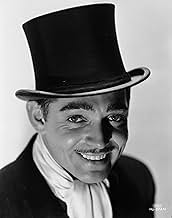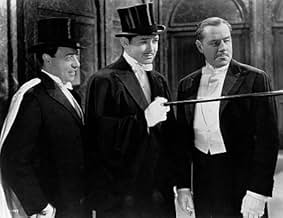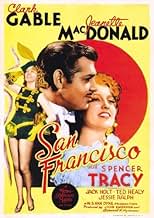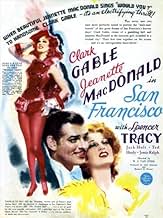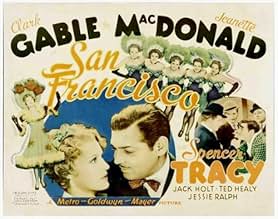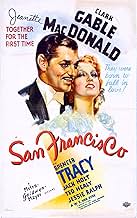VALUTAZIONE IMDb
7,1/10
6429
LA TUA VALUTAZIONE
Aggiungi una trama nella tua linguaA Barbary Coast saloonkeeper and a Nob Hill impresario are rivals for the affections of a beautiful singer, both personally and professionally, in 1906 San Francisco.A Barbary Coast saloonkeeper and a Nob Hill impresario are rivals for the affections of a beautiful singer, both personally and professionally, in 1906 San Francisco.A Barbary Coast saloonkeeper and a Nob Hill impresario are rivals for the affections of a beautiful singer, both personally and professionally, in 1906 San Francisco.
- Regia
- Sceneggiatura
- Star
- Vincitore di 1 Oscar
- 5 vittorie e 6 candidature totali
Charles Judels
- Tony
- (as Charles Judells)
Warren Hymer
- Hazeltine
- (as Warren B. Hymer)
Recensioni in evidenza
San Francisco, like so many other films from this era, just reminds me again how movies today have lost the art of the build-up. They just hit you over the head with mind-numbing action from frame one. Hollywood(and audiences of today) would do well to watch classics like "San Francisco", where story takes precedence over special effects and when the effects do come, they are in service to the story. And they mean so much more and have so much more impact when held back until the last possible moment. Why can't we allow ourselves to be immersed in the story? Or are we just too impatient for it now?
John Hoffman (my father) was responsible for the Great Earthquake scene and a number the other montage sequences in the film. A friend of his, the film preservationist David Shepard, tells me the film had already been shot, but the studio execs weren't happy with it. So, they handed it over to the then head of MGM's Montage Department, John Hoffman, to see if he could salvage it. Hoffman rewrote, directed and edited many of the scenes. The result: five Oscar nominations (including 'Best Picture') and one win ('Best Sound') released in 1936, it preceded the introduction of the Oscar for Special Effects award by a few years.
A few years ago, when the Academy Awards Ceremony featured a review of the greatest disaster films ever made, I was disappointed to note that San Francisco hadn't been included. Still, from reading the reviews posted here, it's great to see how many people still appreciate it today.
A few years ago, when the Academy Awards Ceremony featured a review of the greatest disaster films ever made, I was disappointed to note that San Francisco hadn't been included. Still, from reading the reviews posted here, it's great to see how many people still appreciate it today.
As in the '70s, disaster films were all the rage in the '30s, with "Hurricane," "The Rains Came," "In Old Chicago," and, of course, 1936's "San Francisco" which certainly sent the other studios running to destroy anything they could. The film stars Clark Gable, Jeannette MacDonald, and Spencer Tracy as three citizens of that beautiful city on April 18, 1906, when the big earthquake struck.
Gable plays Blackie Norton, a quintessential role for him - a tough, charming rogue who runs The Paradise Club. MacDonald is the lovely and talented Mary Black who arrives there looking for work, and Spencer Tracy is Father Tim, who is Blackie's conscience (so he ignores him) and Mary's moral compass. Mary is torn between two loves - her love for Blackie and her love for opera. Burley (Jack Holt) wants her contract from Blackie so he can star her at the Tivoli Opera, but in all things, she suppresses her own desires so that she can stay with Blackie. She finally does leave but returns...only to leave again after an ugly confrontation between Blackie and Father Tim. Things get a lot uglier at an annual contest - and that's when the chandelier starts moving back and forth.
It's amazing what the films in the pre-computer age were able to do with special effects because the earthquake in "San Francisco" is dazzling, spectacular, and downright scary. Given the horrors of 9/11 and Katrina, one is drawn into the devastation and suffering as people search for loved ones, watch their houses fall, go crazy, and see their beloved city dynamited because there's no water to stop the raging fires. 70 years later, it's all way too close to home.
As good as he always was with Gable, Spencer Tracy did not have much of a role as the good father, but he's excellent. MacDonald poses a problem. Normally, she plays a diva or spitfire, and she did those roles beautifully. But Mary Blake is a modest and religious woman who speaks softly and sublimates her own desires for the man she loves. It doesn't ring true, and it doesn't work opposite the volatile Blackie of Gable's. If Mary had been more like other roles she played, MacDonald probably would have had good chemistry with him. As it is, they don't make much of a couple. Her singing is pretty until she hits the opera stage - with the combination of the tinny sound system in those days and the way women were trained on high notes then, the end result isn't good. She sings "The Jewel Song," which she often did in concert, the finale of "Faust," and "Sempre Libera." MacDonald was a lyric coloratura and suited to the demands of the opera stage in the '30s, but today she sounds dated as standards have changed.
This is a great film to see to appreciate the artistry of the early technicians. The effects in "San Francisco" hold up against anything that came 40 years later. The ending is pure Hollywood hokum, but very stirring. It gave this viewer goosebumps. Don't miss Hollywood at its very best.
Gable plays Blackie Norton, a quintessential role for him - a tough, charming rogue who runs The Paradise Club. MacDonald is the lovely and talented Mary Black who arrives there looking for work, and Spencer Tracy is Father Tim, who is Blackie's conscience (so he ignores him) and Mary's moral compass. Mary is torn between two loves - her love for Blackie and her love for opera. Burley (Jack Holt) wants her contract from Blackie so he can star her at the Tivoli Opera, but in all things, she suppresses her own desires so that she can stay with Blackie. She finally does leave but returns...only to leave again after an ugly confrontation between Blackie and Father Tim. Things get a lot uglier at an annual contest - and that's when the chandelier starts moving back and forth.
It's amazing what the films in the pre-computer age were able to do with special effects because the earthquake in "San Francisco" is dazzling, spectacular, and downright scary. Given the horrors of 9/11 and Katrina, one is drawn into the devastation and suffering as people search for loved ones, watch their houses fall, go crazy, and see their beloved city dynamited because there's no water to stop the raging fires. 70 years later, it's all way too close to home.
As good as he always was with Gable, Spencer Tracy did not have much of a role as the good father, but he's excellent. MacDonald poses a problem. Normally, she plays a diva or spitfire, and she did those roles beautifully. But Mary Blake is a modest and religious woman who speaks softly and sublimates her own desires for the man she loves. It doesn't ring true, and it doesn't work opposite the volatile Blackie of Gable's. If Mary had been more like other roles she played, MacDonald probably would have had good chemistry with him. As it is, they don't make much of a couple. Her singing is pretty until she hits the opera stage - with the combination of the tinny sound system in those days and the way women were trained on high notes then, the end result isn't good. She sings "The Jewel Song," which she often did in concert, the finale of "Faust," and "Sempre Libera." MacDonald was a lyric coloratura and suited to the demands of the opera stage in the '30s, but today she sounds dated as standards have changed.
This is a great film to see to appreciate the artistry of the early technicians. The effects in "San Francisco" hold up against anything that came 40 years later. The ending is pure Hollywood hokum, but very stirring. It gave this viewer goosebumps. Don't miss Hollywood at its very best.
You can't go wrong with the pairing of two of the great stars of Hollywood, Gable and Tracy......and the great star of the west coast, San Francisco. The role of Blackie Norton may be one of Gable's best, so cynical,so devil-may-care and just a little bit dangerous. Tracy play the understanding priest with his usual aplomb. As he told someone once "Don't ever let them catch you acting".
Gable's attraction to Jeanette McDonald is a little bit unbelievable. She really did belong with Jack Holt in this film......or better yet Nelson Eddy should have showed up at the last minute and swept her away with a song. Gable and McDonald don't mesh at all and there was not much chemistry between them although I must admit she is lovely. Be that as it may, the film is one of the best of Hollywood's mid-30's offerings. There is something for everyone; music, drama, comedy and the finale of the earthquake which is what we are waiting for. And what a spectacle it is!! It is very well done in those days before sophisticated special effects; with tumbling buildings, crashing walls and the inevitable fire. There are a couple of poignant scenes when the firefighters must blow up buildings and homes to control the fire thus destroying lifetimes of work and memories.
The ending is a little bit over the top as those who have lost their families and all that they own, joyously sing the Battle Hymn of the Republic and march up the hill to view the destruction (I'm not sure I would be that upbeat)......but it is still effective. The fade to the modern day (1936) San Francisco is just the right ending note. I highly recommend this film, not only for the Gable/Tracy pairing but also for the general excellence of the production.
Gable's attraction to Jeanette McDonald is a little bit unbelievable. She really did belong with Jack Holt in this film......or better yet Nelson Eddy should have showed up at the last minute and swept her away with a song. Gable and McDonald don't mesh at all and there was not much chemistry between them although I must admit she is lovely. Be that as it may, the film is one of the best of Hollywood's mid-30's offerings. There is something for everyone; music, drama, comedy and the finale of the earthquake which is what we are waiting for. And what a spectacle it is!! It is very well done in those days before sophisticated special effects; with tumbling buildings, crashing walls and the inevitable fire. There are a couple of poignant scenes when the firefighters must blow up buildings and homes to control the fire thus destroying lifetimes of work and memories.
The ending is a little bit over the top as those who have lost their families and all that they own, joyously sing the Battle Hymn of the Republic and march up the hill to view the destruction (I'm not sure I would be that upbeat)......but it is still effective. The fade to the modern day (1936) San Francisco is just the right ending note. I highly recommend this film, not only for the Gable/Tracy pairing but also for the general excellence of the production.
I have just watched the colorized version of this knock-out film. Whether in color or B &W, it is a powerfully entertaining film. When Blackie Norton finds religion and Mary Blake spots him, humbled and on his redemption encrusted knees,tears well up in my jaded eyes. Everything works so wonderfully in this film. Still, as destructive and tragic as the earthquake scenes are,this movie is basically a love story and what male would not swoon over the voice and the innocence of Mary Blake. Certainly not me.
Lo sapevi?
- QuizClark Gable did not want to make this film but he was at the mercy of MGM studio head Louis B. Mayer, who had just paid off one of his numerous paramours.
- BlooperAs Blackie walks away from a building being blown up (actually a process shot), Clark Gable's head becomes momentarily transparent.
- Citazioni
Jack Burley: [referring to Mary Blake] Well, there's no law against an opera singer being slender, young and beautiful.
- Curiosità sui creditiPrologue: "San Francisco--guardian of the Golden Gate--stands today a Queen among seaports--industrious, mature, respectable. But perhaps she dreams of the Queen and city she was--splendid and sensuous, vulgar, and magnificent--that perished suddenly with a cry still heard in the hearts of those who knew her, at exactly 5:15 a.m. April 18, 1906."
- Versioni alternativeAfter initial premiere, the manager of the Paramount Theater in San Francisco added to the downbeat ending a few shots showing the Golden Gate Bridge being built. Seeing the positive public reaction, MGM decided to have the sequence added to all other prints in release.
- ConnessioniEdited into What Price Safety! (1938)
- Colonne sonoreSan Francisco
(1936)
Music by Bronislau Kaper and Walter Jurmann
Lyrics by Gus Kahn
Played during the opening credits and often in the score
Sung by Jeanette MacDonald (uncredited)
Reprised by her and others at a political rally and at the end
I più visti
Accedi per valutare e creare un elenco di titoli salvati per ottenere consigli personalizzati
- How long is San Francisco?Powered by Alexa
Dettagli
Botteghino
- Budget
- 1.300.000 USD (previsto)
- Tempo di esecuzione1 ora 55 minuti
- Colore
- Proporzioni
- 1.37 : 1
Contribuisci a questa pagina
Suggerisci una modifica o aggiungi i contenuti mancanti


